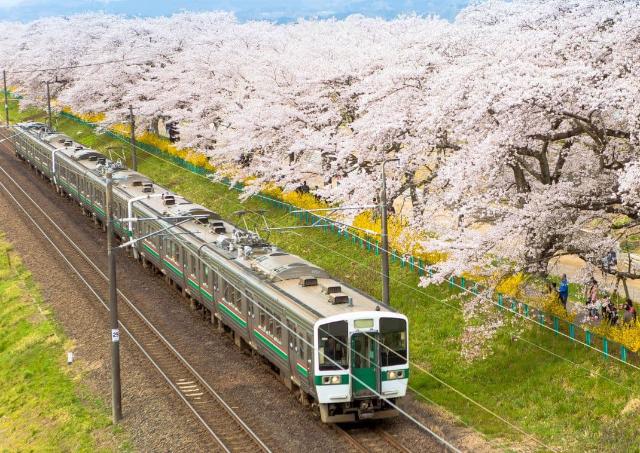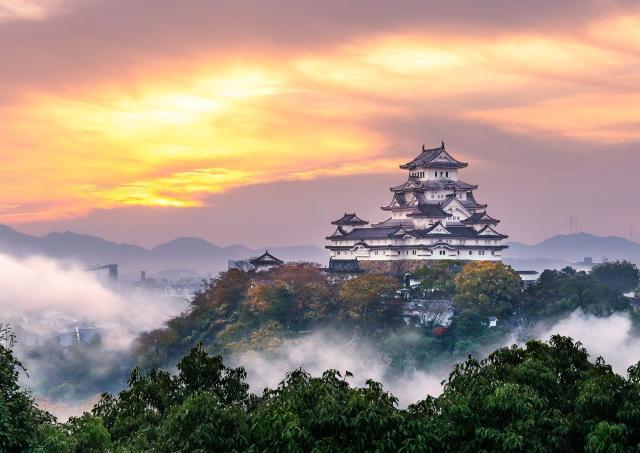Explore More of Japan with Regional Passes
What are Regional Passes?
One of the most well-known Japan travel passes is the Japan Rail Pass, which is the best option if you are intending to travel across a lot of Japan in seven days or more. But if you are only in Japan for a week or less, it may be difficult to travel such great distances each day. In that case, narrowing down your travels to a smaller area might be a better option. That’s where regional passes come in.
Regional passes allow you to use trains and public transport within a certain area of Japan. Each pass is slightly different, as some may offer the option of one day or multiple days. Others may offer different transport methods like ferries and bicycles included in the price.
The passes can be bought outside of Japan, so here we will show you how to make the most of regional passes before ordering your own.
Types of Regional Passes
The Japan Railways (JR) system is made up of six regional JR companies, from JR Hokkaido in the north to JR Kyushu in the south. Some passes only cover one area, while others combine with neighbouring areas.
Aside from the Japan-wide Japan Rail Pass, some of the popular options are the Kansai Area Pass which grant you access to Kyoto and Osaka, and the Hokkaido Rail Pass to travel to areas like Sapporo and Hakodate.
There are over 30 different types of passes! Here, we’ll focus on the following, most popular ones:
Kansai Area Pass
Kansai-Hiroshima Area Pass
Sanyo San’in Area Pass
Takayama-Hokuriku Area Tourist Pass
Hokuriku Arch Pass
Coverage Areas
Although each of these five passes include Kyoto and Osaka, they branch out in completely different directions, offering you the chance to explore different parts of Japan.
For example, if you want to cover both Tokyo and Kyoto, the Hokuriku Arch Pass is a good way to explore areas along the way. However, if you are more interested in shorter trips near Kyoto, the Kansai Area Pass might be a better option.
Kansai Area Pass
Kyoto, Nara, Osaka, Himeji, KobeKansai-Hiroshima Area Pass
Hiroshima, Kyoto, Osaka, Kobe, Nara, Kansai Airport, HimejiSanyo San’in Area Pass
Kyoto, Osaka, Kobe, Himeji, Hiroshima, Fukuoka, HagiTakayama-Hokuriku Area Tourist Pass
Nagoya, Takayama, Shirakawago, Toyama, Kanazawa, Kyoto, and OsakaHokuriku Arch Pass
Osaka, Kyoto, Nara, Kansai Airport, Hokuriku, Toyama, Tokyo, Narita
Validity Periods
Most passes allow you to use them for a set number of consecutive days. The Kansai Area Pass is one of the few that allows you to choose between one to four days for different prices.
All passes mentioned here begin once activated at the station counter (valid from 0:00 that morning) and expire once they reach 24:00 of the final day of the pass. For example, if you activate the Hokuriku Arch Pass on Monday at 10am, you can use it until midnight on Thursday.
Kansai Area Pass
One, two, three, and four-day passesKansai-Hiroshima Area Pass
Five consecutive daysSanyo San’in Area Pass
Seven consecutive daysTakayama-Hokuriku Area Tourist Pass
Five consecutive daysHokuriku Arch Pass
Four consecutive days
Costs and Savings
The regional passes may seem pricey at first, but when you start to compare prices against traveling without them, you’ll quickly see how money-saving they can be! Here are the prices we offer for the regional passes.
Kansai Area Pass (Adult Price /Child Price)
Day Pass: ¥2,800 / ¥1,400
2-day pass: ¥4,800 / ¥2,400
3-day pass: ¥5,800 / ¥2,900
4-day pass: ¥7,000 / ¥3,500
Kansai-Hiroshima Area Pass (Adult Price /Child Price)
5-day pass: ¥17,000 / ¥8,500
Sanyo San’in Area Pass (Adult Price /Child Price)
7-day pass: ¥23,000 / ¥11,500
Takayama-Hokuriku Area Tourist Pass (Adult Price /Child Price)
5-day pass: ¥19,800 / ¥9,900
Hokuriku Arch Pass (Adult Price /Child Price)
7-day pass: ¥30,000 / ¥15,000
Let’s compare that to an example route with and without the Kansai Area Pass.
Sample Prices with and without the Kansai Area Pass
Day 1
Route: Kansai Airport to Kyoto Station on Airport Express Haruka. Kyoto Station to Nanzenji Temple return
Without Pass Daily Total: ¥3,960
Without Pass Cumulative Total: ¥3,960
With Pass Cumulative Total: ¥2,800
Day 2
Route: Kyoto Station to Nara Station return
Without Pass Daily Total: ¥1,440
Without Pass Cumulative Total: ¥5,400
With Pass Cumulative Total: ¥4,800
Day 3
Route: Kyoto Station to Kinkakuji return bus, plus Kyoto Station to Uji Station return
Without Pass Daily Total: ¥940
Without Pass Cumulative Total: ¥6,340
With Pass Cumulative Total: ¥5,800
Day 4
Route: Kyoto Station to Himeji Station one way
Without Pass Daily Total: ¥2,310
Without Pass Cumulative Total: ¥8,650
With Pass Cumulative Total: ¥7,000
*Non-pass pricings are subject to change and vary by lines and routes taken. Pricings listed as of February 2024.
These are the most basic routes that do not include smaller trips to other spots along the way, or any extra travel on Day 4. Even so, there is an overall saving!
The best way to make the most of these passes is to explore at least two of the areas covered, rather than sticking to one city. Seeing as Japan’s public transport is well-connected and generally very efficient, it’s easy to visit another city on a day trip and spend the rest of the time in the same place and still make savings with the passes.
As you can see above, Day 3 stays closest to central Kyoto, so although there is no saving for that day, overall, there is a saving for the four days.
If you intend to stay in one area, you can easily stay there after the pass has expired. Read on to see more examples of how to make the most of each pass.
Transportation Modes
Below you’ll notice that many of the passes allow routes on “JR” lines. JR is Japan Railways, and they cover most major tracks around Japan. This may not mean much to you now, but may be important information when planning your routes later or deciding whether to explore an area separated by ferry.
However, passes usually do not include rides on smaller rural lines, “romance cars” or other luxury liners. They also often do not include the fastest “Nozomi” lines of shinkansen, and may not cover subway systems.
Kansai Area Pass
Local JR lines and JR West buses
Non-reserved seats on the Haruka airport express train
One-day subway card for Karasuma and Tozai lines
Kansai-Hiroshima Area Pass
Sanyo Shinkansen between Shin-Osaka and Hiroshima (including Nozomi and Mizuho trains)
JR local trains and Limited Express trains
JR local buses in Kyoto and Hiroshima
Ferry to Miyajima
Kyoto Tango Railway
Free bicycle loan at spots with "Ekirin-kun" service
Sanyo San’in Area Pass
Sanyo Shinkansen between Shin-Osaka and Hakata (Fukuoka)
JR local trains and Limited Express trains
JR local buses in Kyoto, Hiroshima, and Yamaguchi
JR Express Bus between Yamaguchi and Hagi
Ferry to Miyajima
Free bicycle loan at spots with "Ekirin-kun" service
Takayama-Hokuriku Area Tourist Pass
JR Hokuriku Shinkansen
JR local trains and Limited Express trains (areas between Nagoya to Toyama and Osaka to Kanazawa)
JR local trains in central Osaka
JR trains between Osaka and Kansai Airport Buses between Takayama, Toyama, and Kanazawa
Buses between Takaoka, Gokayama, and Shirakawago
Hokuriku Arch Pass
JR Hokuriku Shinkansen (between Tokyo and Osaka)
JR local and limited express trains in central Osaka and Tokyo (including trains to Narita, Haneda, and Kansai Airports)
JR local and limited express trains in covered Hokuriku areas
Does not include Tokaido/Sanyo Shinkansen
Purchase and Activation
Once you’ve decided on which regional pass is the best for you, all that’s left to do is order your pass!
If you would like to buy the JR Pass or any of the Japan regional passes mentioned, get in touch via email at jrp@japanspecialist.com.
Once you have made your payment, you will receive an exchange voucher in the post within 1-3 business days. This exchange voucher is not your regional pass, but is vital for receiving the pass once you arrive in Japan.
Once you’re in Japan, take the exchange voucher to a JR service counter at an applicable train station to activate your pass and start exploring. You must activate your pass within three months of receiving the exchange voucher. You can check Japan Rail Pass exchange locations here by checking “Exchange of MCO”.
Popular Destinations and Attractions
With these passes, there are tons of ways to explore Japan! We’ve put together some basic sample itineraries for you to make the most of your pass.
- Kansai Area Pass
Day 1: Kyoto city
Attractions: Kinkakuji Temple, Kiyomizudera, Byodo-in, traditional tea shopsDay 2: Nara
Attractions: Nara Park (deer), Todai-ji Temple, Kofuku-jiDay 3: Osaka
Attractions: Osaka castle, Dotonbori, Universal Studios JapanDay 4: Himeji
Attractions: Himeji Castle, Koko-en, Engyoji Temple - Kansai-Hiroshima Area Pass
Day 1: Kyoto
Attractions: Kinkakuji Temple, Kiyomizudera, Nanzen-ji TempleDay 2: Nara
Attractions: Nara Park (deer), Todai-ji Temple, Kofuku-jiDay 3: Osaka
Attractions: Umeda Sky Building, Namba Yasaka Shrine, Aquarium KaiyukanDay 4: Osaka
Attractions: Universal Studios JapanDay 5: Hiroshima
Attractions: Hiroshima Peace Memorial Museum, Hiroshima Castle - Sanyo San’in Area Pass
Day 1: Kyoto
Attractions: Kinkakuji Temple, Kiyomizu-dera, Nanzen-ji TempleDay 2: Kobe
Attractions: Kobe Port Tower, Ikuta Shrine, Kobe Nunobiki Herb GardensDay 3: Takamatsu
Attractions: Takamatsu Castle, Ritsurin GardenDay 4: Hiroshima
Attractions: Hiroshima Peace Memorial Museum, Hiroshima CastleDay 5: Hiroshima
Attractions: Itsukushima Shrine (by ferry), Miyajima RopewayDay 6: Fukuoka
Attractions: Marine World, Umi no Nakamichi Seaside ParkDay 7: Fukuoka
Attractions: Fukuoka Castle Ruins, Dazaifu Tenmangu Shrine - Takayama-Hokuriku Area Tourist Pass
Day 1: Shirakawago
Attractions: Traditional huts and walking routesDay 2: Kanazawa
Attractions: Kenrokuen Gardens, Higashi Chaya DistrictDay 3: Fukui
Attractions: Maruoka Castle, Daihonzan Eihiji TempleDay 4: Kyoto
Attractions: Kinkakuji Temple, Kiyomizu-dera, Nanzen-ji TempleDay 5: Osaka
Attractions: Umeda Sky Building, Namba Yasaka Shrine, Dotonbori - Hokuriku Arch Pass
Day 1: Tokyo
Attractions: Tokyo Skytree, Senso-ji Temple, Imperial PalaceDay 2: Karuizawa
Attractions: Picchio Wildlife Research Center, Harunire Terrace, Kyu Karuizawa shopping streetDay 3: Kanazawa
Attractions: Kenrokuen Gardens, Higashi Chaya DistrictDay 4: Osaka
Attractions: Umeda Sky Building, Namba Yasaka Shrine, Dotonbori
Things to Keep in Mind About Regional Passes
There are a few things to keep in mind when ordering and using your pass around Japan:
The passes are only available to those on a tourist visa visiting Japan from abroad.
The voucher that you receive in the post after purchasing online must be exchanged within Japan for the actual pass. You cannot board transportation with the exchange voucher.
You must show your passport when exchanging your voucher for your pass.
Lost or stolen passes will not be reissued.
Shinkansen first class and Green Car seats are not included in the pass prices.
When using trains with reserved seating, reserve seats in advance before boarding.
Additional minor fees may be charged for ferry usage.
Take Your Japan Travels to the Next Level
With these regional passes, you can easily explore places you may not have thought about before without worrying about the cost. Use Kyoto or Osaka as your base, and head further afield for day trips and cultural adventures. The passes are the best value for money when you let your adventurous side out!
If you’re ready to get started, send us an email to get your pass and begin your Japan journey: jrp@japanspecialist.com.




